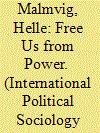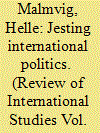|
|
|
Sort Order |
|
|
|
Items / Page
|
|
|
|
|
|
|
| Srl | Item |
| 1 |
ID:
134380


|
|
|
|
|
| Summary/Abstract |
For over a decade, Arab governments have been enrolled into EU initiatives aimed at promoting democratic reform in the region. Common to these initiatives are their claims to be uninvolved with power and external imposition, professing instead to be based on voluntary notions of local demand and ownership. This article challenges this core liberalist assumption of the absence of power. Drawing on Foucault's reflections on liberal governmentality, it shows how power operates through a technology of “contractualization” which produces a distinct Arab subjectivity in the form of a lack (of reform will). Yet governing technologies are never complete, and possibilities of reversal and resistance always exist. In the second part, the article engages with the emerging debate on Foucault's concept of counter-conduct, opening up the concept to more subtle and less spectacular forms of resistance. Drawing inspiration from Derrida's analysis of (in)hospitality and Baudrillard's logic of simulation, the article shows how the liberal assumptions of “invitation,” “ownership,” and “gradualism” inherent in European reform initiatives enable resistance in the form of: (i) selection of entry; (ii) setting conditions; and (iii) simulating reform.
|
|
|
|
|
|
|
|
|
|
|
|
|
|
|
|
| 2 |
ID:
192319


|
|
|
|
|
| Summary/Abstract |
Humour has recently emerged as an important research topic in International Politics. Scholars have investigated how states and state leaders practice humour as part of their diplomatic exchanges, in misinformation campaigns, and nation-branding. Important knowledge has been gained as to how humorous practices partake in constituting identities, managing recognition, and international anxieties or contesting global orders. Yet, little attention has been devoted to interrogating the risk that humorous practices may give rise to in international politics, to the underside of humour's productive power. This article aims to begin unpacking these risks both theoretically and empirically. To do so, it engages with the critical thinking on humour by Kierkegaard and Foster Wallace in particular, suggesting three challenging implications: (1) humorous entrapments; (2) facile forms of detached engagement; and (3) ambiguous blurring of fiction and reality. It then shows how these unfold empirically in: Iran's meme war with the US, a Yes Men's parody during COP15, and the Pyongyang Nuclear Summit, developing a three-pronged analytical strategy for studying humorous practices and their different relations to formations of power/knowledge.
|
|
|
|
|
|
|
|
|
|
|
|
|
|
|
|
| 3 |
ID:
172552


|
|
|
|
|
| Summary/Abstract |
This article sets out to bring sound and music to the field of visual studies in International Relations. It argues that IR largely has approached the visual field as if it was without sound; neglecting how audial landscapes frame and direct our interpretation of moving imagery. Sound and music contribute to making imagery intelligible to us, we ‘hear the pictures’ often without noticing. The audial can for instance articulate a visual absence, or blast visual signs, bring out certain emotional stages or subjects’ inner life. Audial frames steer us in distinct directions, they can mute the cries of the wounded in war, or amplify the sounds of joy of soldiers shooting in the air. To bring the audial and the visual analytically and empirically together, the article therefore proposes four key analytical themes: 1) the audial–visual frame, 2) point of view/point of audition, 3) modes of audio-visual synchronization and 4) aesthetics moods. These are applied to a study of ‘war music videos’ in Iraq and Syria made and circulated by Shi'a militias currently fighting there. Such war music videos, it is suggested, are not just artefacts of popular culture, but have become integral parts of how warfare is practiced today, and one that is shared by soldiers in the US and Europe. War music videos are performing war, just as they shape how war is known by spectators and participants alike.
|
|
|
|
|
|
|
|
|
|
|
|
|
|
|
|
|
|
|
|
|